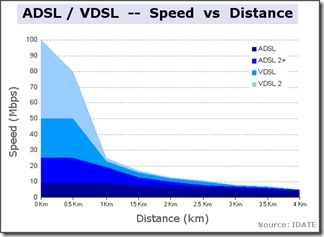 ADSL (Asymmetric Digital Subscriber Line) and VDSL (Very High Bitrate Digital Subscriber Line) mainly differ in the speed of data transmission or data rate, where VDSL is significantly faster than ADSL. ADSL provides upstream rate 64 Kbps to 1 Mbps, and downstream rate 500 Kbps to 8Mbps whereas VDSL provides upstream rate 1.5 to 2.5 Mbps and downstream rate 50 to 55 Mbps.
ADSL (Asymmetric Digital Subscriber Line) and VDSL (Very High Bitrate Digital Subscriber Line) mainly differ in the speed of data transmission or data rate, where VDSL is significantly faster than ADSL. ADSL provides upstream rate 64 Kbps to 1 Mbps, and downstream rate 500 Kbps to 8Mbps whereas VDSL provides upstream rate 1.5 to 2.5 Mbps and downstream rate 50 to 55 Mbps.
ADSL and VDSL are the variants of DSL technology. DSL stands for Digital Subscriber Line which basically transforms an ordinary telephone line into a broadband communication link.
Content: ADSL Vs VDSL
-
Comparison Chart
-
Definition
-
Key Differences
-
The Limitations
-
Conclusion
Comparison Chart
|
BASIS FOR COMPARISON |
ADSL |
VDSL |
|---|---|---|
|
Data Rate |
Upstream- 64 Kbps to 1 Mbps |
Upstream- 1.5 to 2.5 Mbps |
|
Loop reach |
18000 feet |
4500 feet |
|
Service types |
Data and POTS shared line |
Symmetric data and POTS |
|
Principle application |
Internet access, data HDTV, VOD (video on demand). |
Internet access, data |
|
Modulation used |
CAP or DMT |
DMT |
|
Common protocol |
PPP over ATM |
ATM |
Definition of ADSL
Asymmetric digital subscriber line (ADSL) as the name suggests the distribution of bandwidth is not identical, which means it provides unequal data rates at upstream and downstream. The bit rate at downstream is usually higher than the upstream.
ADSL splits the bandwidth (1 Megahertz) of the twisted pair cable into three bands. The first band ranged from 0 to 25 kHz and utilised as a regular telephone service (also known as POTS); additionally, the service consumes only 4 kHz of the band, and the remaining is used as guard band which separates the voice channels from the data channels. The second band ranges between 20 to 200 kHz, is used for upstream communication. The third band usually ranges between 200 to 1 MHz, is used for downstream communication. The ADSL technology can cover a distance up to 18000 feet.
Definition of VDSL
Very High Bitrate Digital Subscriber Line (VDSL) technology is similar to ADSL with some enhancements. It uses coaxial, fibre optic or twisted pair cable for short distances up to 4500 feet. The modulating technique used in VDSL is DMT (Discrete Multitone Technique), which is the combination of QAM and FDM.
VDSL provides greater capacity than ADSL on short lines. Another merit of VDSL is the security which it offers by point to point links. It uses seven different bands for enabling customization of upstream and downstream rates. VDSL covers existing services like POTS, ISDN, ADSL, etc. VDSL is appropriate for the full-service network; it provides services like High definition TV and VOD(Video on demand).
Key Differences Between ADSL and VDSL
-
ADSL provides maximum 8Mbps downstream bit rate and 1 Mbps upstream bit rate. On the other hand, VDSL provides 55 Mbps downstream bit rate and 2.5 upstream bit rate.
-
ADSL technology covers a larger distance than VDSL, where ADSL can cover 18000 feet, and VDSL can reach up to 4500 feet.
-
VDSL can support asymmetric as well as symmetric data and POT services while ADSL supports only asymmetric data and POT services.
-
VDSL can offer applications such as High definition TV and VOD which could not be possible in case of ADSL.
-
ADSL is more extensively used as compared to VDSL.
-
VDSL can easily be affected by attenuation. In contrast, ADSL immune to attenuation at some extent.
-
Discrete Multitone Technique (DMT) is used in VDSL for modulation. On the contrary, ADSL can either uses CAP (Carrierless Amplitude/ Phase) or DMT.
The Limitations of Off-Net Hybrid Fiber-Copper Networks
 The maximum available speed drops dramatically the farther away you get from a traditional carrier’s fiber POP for ADSL and VDSL.
The maximum available speed drops dramatically the farther away you get from a traditional carrier’s fiber POP for ADSL and VDSL.
After the first mile (1.6 km), you can’t even get 20 Mbps.
But ECC’s patented new technology delivers 120 Mbps at distances of up to 10 miles.
Conclusion
ADSL and VDSL are essentially the types of Digital subscriber line technology. VDSL provides high data rates for short reaches of twisted pair copper telephone lines while ADSL offers low data rates as compared to ADSL which cover a larger distance than VDSL. VDSL has certain demerits such as it is expensive and the signal speed degrades as the distance increases.
